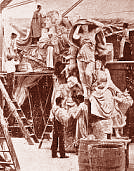

![]()
![]()
This Page:
Janet Scudder
Mary T. Lawrence (Tonetti)
Anna M. Valentien
Luella Varney (Serrao)
Bessie Potter Vonnoh
Mary Seton Watts
Julia Bracken Wendt
Jenny Weyl
Anne Whitney
Enid Bland Yandell
![]()
![]()

Frog Fountain c. 1899--
representative work.
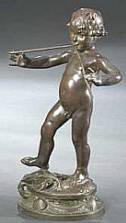
The Young Pan--
representative work.
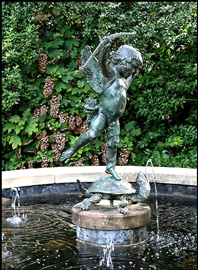
Cupid atop Tortoise: Fountain
--representative work
"A Nymph"--commissioned statue exhibited in
the Indiana State Building, 1893 Exposition.
See image of Scudder statuary.
Justice (image unavailable)--commissioned statue
exhibited in the Illinois building,
1893 Exposition.
Janet Scudder was one of the most successful American women sculptors of the early twentieth century, but only after enduring considerable discrimination as a woman in the 1890s. Born Netta Scudder in Terra Haute, Indiana, she first studied art at the Cincinnati Art Academy and then became a "white rabbit" or studio assistant to Lorado Taft at the 1893 World Fair, working on the entryway statuary "The Sleep of the Flowers" and "The Awakening [or Battle] of the Flowers] to the Horticultural Building at the 1893 Exposition (see Taft's White Rabbits). She also received commissions to create two heroic-sized statues for the Illinois ("Justice") and Indiana ("Nymph") buildings. Scudder won a medal at the 1893 Exposition. Despite this experience, she had trouble getting accepted into Frederick MacMonnies' male-dominated studio in Paris and nearly despaired of being recognized as a sculptor when she returned to New York. However, with the creation of her playful fountains and garden statuary, she achieved great popularity. Scudder wrote her autobiography Modeling my Life in 1925.
![]()

Figure of Columbus planting the Spanish flag
in the New World--exhibited in front of the
Administration Building, 1893 Exposition.
See Lawrence statue.
Mary Lawrence Tonetti was born into a prominent New York family and became an assistant in 1888 to the famous sculptor Saint-Gaudens who was in charge of selecting sculptors for the public statues at the 1893 Exposition. He chose his former pupil Lawrence to create the Columbus statue (although Saint-Gaudens co-signed it). Later she would attend the Académie Julian. Eventually she had a studio of her own and married French sculptor Francois Tonetti.
![]()

Hero Waiting for
Leander--
representative work.

Ariadne--exhibited in the
Cincinnati
Room, the
Woman's Building,
1893 Exposition
(sculptor Anna Valentien
in background).
Anna M. Valentien was born in Cincinnati, Ohio, to a German immigrant family named Buchdrucker (later Anglicized to "Bookprinter"). She studied portraits with Frank Duveneck and sculpture with Louis T. Rebissoat at the Cincinnati Art Academy. Some years later, she continued her studies in Paris at Académie Colarossi with Jean Antonin Injalbert and at the Academy Rodin with Auguste Rodin, Emile Bourdelle and Jules Des Bois. Anna and her artist-husband (Albert Valentien) were decorators with Rookwood Pottery in Cincinnati for over twenty years, after which they moved to San Diego and were instrumental in bringing the arts and crafts movement to that area. She also taught pottery and sculpture at several local schools.
![]()
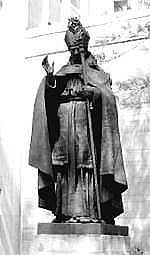
Reverend Amadeus
Rappe, D.D 1888--
representative work.

Mark Twain--exhibited in
Fine Arts Palace,
1893 Exposition.
Portrait bust of a Lady and Portrait bust of
Edith Van Buren (images unavailable)--
exhibited in Fine Arts Palace, 1893 Exposition.
Marble bust [title not given]--exhibited in the
Rotunda, Woman's Building, 1893 Exposition.
Luella Varney was born in Cleveland, Ohio and educated in Rome where she lived for a good portion of her life. In addition to the sculptures listed on this page, she also made busts of Julia Ward Howe and Mary Baker Eddy. No other information is available online.
![]()

American Girl --
representative work.
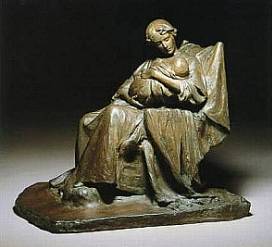
Young Mother c. 1896--
representative work.

Butterflies --
representative work.

The Spirit of the Water 1896--
representative work.

Bust of a Gentleman--
representative work.
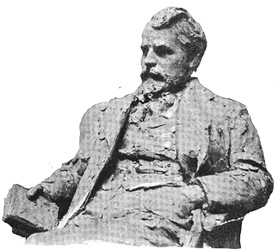
Hamlin Garland (plaster sketch)--
representative work.
Portrait of Professor David Swing and Portrait
in Relief [Mr. MacGillivray] (images unavailable)--
exhibited in Fine Arts Palace, 1893 Exposition.
Bessie Potter Vonnoh was raised in Chicago where she studied at the Art Institute. She was one of Lorado Taft's female assistants (called "white rabbits") working on the statuary groups "The Sleep of the Flowers" and "The Awakening [or Battle] of the Flowers" displayed at the entrance of the Horticultural Building at the 1893 World Fair (see Taft's White Rabbits); she also did the commissioned sculpture called "Art" displayed in the Illinois State Building. After studying in Paris, she returned to America and considerable success with her graceful statuettes. She and her husband-painter Robert Vonnoh were part of the art colony at Old Lyme, Connecticut.
![]()
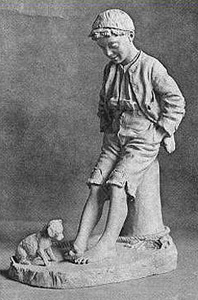
Boy and Dog--exhibited in the
Woman's Building, 1893 Exposition.
Mary Seton Watts (born Mary Fraser Tytler) was born in India, but raised by her grandparents in Scotland where she studied painting at the Slade and South Kensington School of Art. She married the much older painter George Frederic Watts and at some point evidently studied sculpting in London and Paris. An amateur portrait painter before her marriage, she became a social reformer afterwards by establishing the Potters Guild and the Arts & Crafts Guild in Compton, Surrey, to teach terracotta modeling to the local villagers and gentry. They provided the labor for the remarkable Watts Chapel and Gallery which were designed and decorated with symbolic terracotta tiles by Mary Watts and dedicated to the preservation of the artistic reputation of her husband. Mary Watts is remembered for her Celtic and Art Nouveau bas-reliefs, pottery, and textiles. Her small statuettes, like the one pictured above, were made of terracotta clay, painted with watercolors, and waxed.
Mary Fraser Tytler (aka Mary Seton Watts) Biography
![]()
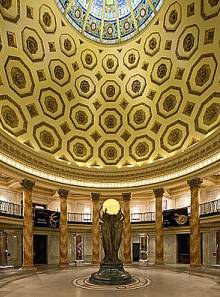

The Three Graces: Art, Science and History (1914)--
in the renovated rotunda at the Natural History Museum
of Los Angeles County; sometimes titled The Three Muses.
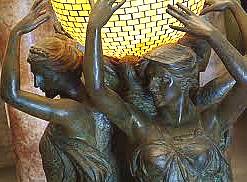
The Three Graces: Art, Science
and History (1914)--close-up.
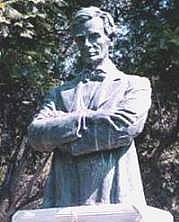
Lincoln
the Lawyer 1925--
representative work.

The Apache Fire Hole--
representative work.
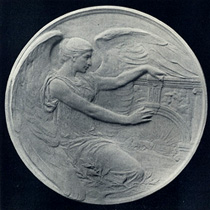
Chicago Society of
Artists Medal 1905--
representative medallion.

James Monroe--
representative work.
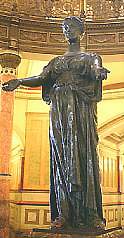
Illinois Welcoming the Nations--
exhibited in the Illinois State
Building, 1893 Exposition.
Julia Bracken Wendt was born into a large Irish Catholic family in Apple River, Illinois. She studied at the Chicago Art Institute under Lorado Taft and became one of his female assistants, called "White Rabbits," at the 1893 World Fair where, among other duties, she played a primary one in creating The Awakening of the Flowers designed by Taft to decorate the entrance of the Horticultural Building. Her independently-commissioned statue representing the women of Illinois (Illinois Welcoming the Nations) was also exhibited at the Illinois State Building and later placed in the Illinois state capitol along with her statue of James Monroe. After she and her husband (landscape painter William Wendt) moved to California, she created a eleven-foot high allegorical work The Three Graces: Art, Science and History (1914)--draped goddesses holding up an electrically lit globe--currently on display in the Los Angeles County Museum of Natural History. She became the city's leading sculptor.
![]()
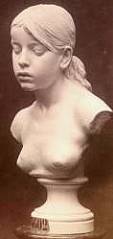
Fifteen Years (1888)--exhibited in
Fine Arts Palace, 1893 Exposition
Lucrezia Buti (images unavailable)--
exhibited in Fine Arts Palace, 1893 Exposition.
Daughter of a textile merchant, Jenny Weyl was born in Lure and studied sculpture with French sculptor Hélène Bertaux. She married a naval officer and traveled in Africa and Spain. No other information is available online.
![]()

Ethiopia Shall Soon Stretch Out Her Hands to God,
or Africa 1862--representative work.
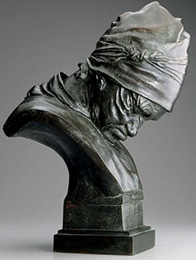
Le Modelè [Portrait of a
Former Slave] 1885--
representative work
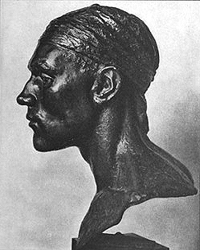
Head of a Spanish Peasant--
representative work.
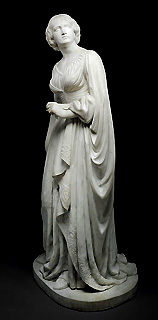
Lady Godiva--
representative work
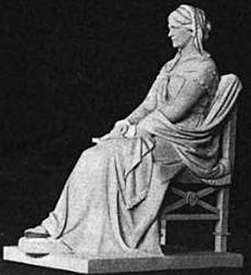
Harriet Martineau--
representative work.
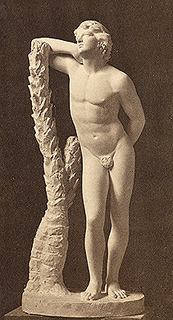
The Lotus Eater--
representative work.

Chaldean Shepherd c. 1867
--representative work.
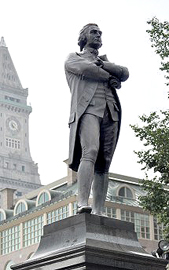
Samuel Adams--
representative work.
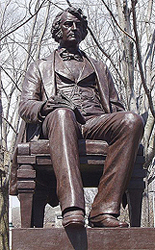
Charles Sumner,
Cambridge,
Harvard Square--
representative work.
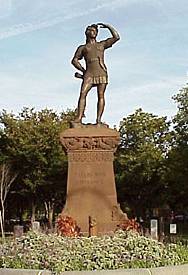
Lief Ericsson 1887--
scroll down the page.
Representative work.

Roma (1890)--
exhibited in Fine Arts
Palace, 1893 Exposition.
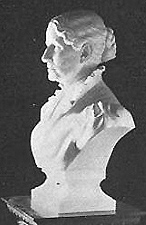
Mrs. Mary R. Livermore--
representative work.

Bust of Lucy Stone--
exhibited
in Woman's
Building, 1893 Exposition.
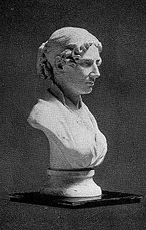
Harriet Beecher Stowe
1890--
exhibited
in New York Library,
Woman's Building,
1893 Exposition.
At the 1893 World Fair, Anne Whitney was an established older American sculptor. Born in Watertown, Massachusetts and educated in art at the Pennsylvania Academy of Fine Arts and in Boston, Paris, and Rome, Whitney had one commission rejected when it was discovered that she was a woman sculptor. However, she ended up creating many prominent statues, such as her marble sculpture of the Revolutionary War hero Samuel Adams in Statuary Hall in the Capitol Building in Washington, D.C. Her sculptures often carried a social message. Africa (1864) showed a woman awakening from the sleep of slavery, and Roma represented the poverty in Rome as a beggar-woman. She also sculpted busts of suffragists and abolitionists she admired. Her partner was Abby Adeline Manning, a painter.
![]()
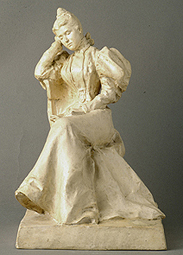
Gibson Girl 1895--
representative work.
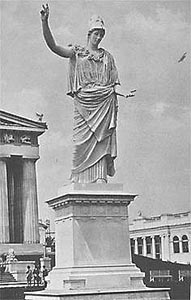
Athena
--
representative work.

Yandell standing next to the
head of her large Athena statue
--representative work.

Victory
--representative work.
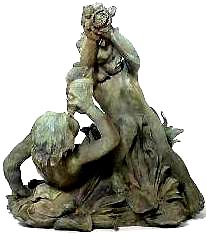
Boys with Sea Shells--
representative work.

Daniel Boone 1895----exhibited next to the
Kentucky Building, 1893 Exposition.
See Boone statue outside Kentucky Building
(right-side
of photo; click to enlarge). See also color pic of Boone.
See also Caryatids--
Woman's Building, 1893 Exposition.
Portrait bust of Dr. D. W. Yandell and
gargoyle Quasi Mordo (images
unavailable)--
exhibited in Woman's Building, 1893 Exposition.
Enid Yandell, from a prominent and supportive Louisville, Kentucky family (her father was a physician), studied at the Cincinnati Art Academy after graduating from college with a double major in chemistry and art. Later she studied with Laredo Taft and Philip Martiny in Chicago, Karl Bittner in New York, and Frederick MacMonnies in Paris. Besides her Daniel Boone and the caryatids for the roof garden of the Woman's Building, Yandell's other statues at the 1893 World Fair included Henry Clay and her "Parthenon" statues on the porticoes of the Columbian Exposition Hall. She won a Special Designer's Medal at the 1893 Exposition. Along with two associates, Yandell wrote Three Girls in a Flat (1892) based on her personal experiences with the Woman's Building. Her later 42-foot high figure of Athena was the largest figure designed by a woman. Yandell was the first woman to become a member of the National Sculpture Society.
![]()
![]()
Jeanne Madeline Weimann, The Fair Women, Chicago 1981.
F. Graeme Chalmers, Women in the Nineteenth Century Art World, Westport 1988.
Paul V. Galvin, World's Columbian Exposition of 1893, Library Digital History Collection, Illinois Institute of Technology.
Maud Howe Elliott, ed. Art and Handicraft in the Women's Building of the World's Columbian Exposition. Rand, McNally, 1894.
Halsey Cooley Ives, ed. World's Columbian Exposition, 1893: Official Catalogue. Part X. Department K. Chicago 1893.
World's Columbian Exposition Exhibition Catalog. Revised Catalogue, Department of Fine Arts, with Index of Exhibitors. Chicago 1893.
![]()
![]()
Return to International Women Sculptors, p. 1
Return to Site Index
![]()
![]()
Text written by K. L. Nichols
Photograph, top of page: Larado Taft and his "White Rabbits"
(primarily Julie Bracken) preparing "The Battle of the Flowers"
statuary for the Agricultural Building entryway.
Return to Nichols Home Page
Suggestions/Comments: knichols11@cox.net
Posted: 6-25-02; Updated: 5-25-19